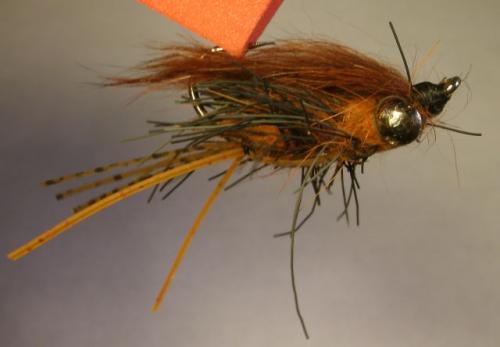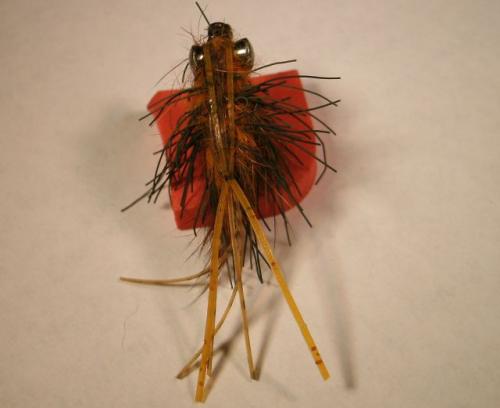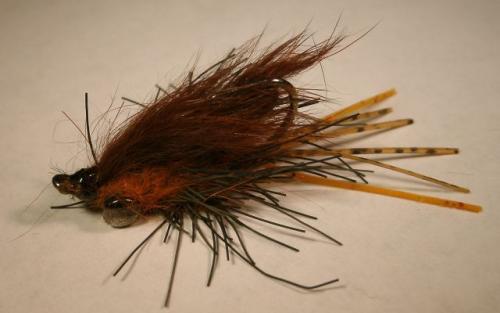


Thread: 140 Ultra-Thread, black
Hook: Mustad 3906 Size 4 or Tiemco 760SP size 4 (Short shank, wide gape, heavy gauge wet fly hooks)
Eyes: 5/32 Black Dazzle eyes.
Weight: 15 wraps of .025" lead
Tail / Belly: Rubber Buggy Nymph Legs, 2 orange 4 brown (Belly is on the top of the hook for this fly)
Body: Swisher's Rub a Dub, Orange.
Wing: Brown zonker strip (On the hook side for this fly)
Directions:
- Tie in the Dazzle eyes well forward on the top of the hook.
- Add lead wraps on the hook shank between the hook-point and behind the Dazzle eyes.
- The rubber legs will be used both to create a splayed tail and the belly of the fly. Cut the rubber legs about 3" long. Tie them in on the top of the hook shank so that half hangs forward and half aft.
- The portion of the legs hanging forward is now in the way. Fold it back and over-wrap it a couple of times. There will now be 12 rubber strands hanging backwards.
- Create a dubbing loop and fill about 3-4" of the loop with Swisher's Rub a Dub. Do not over-fill the dubbing loop or the fly will come out extremely bulky.
- Spin the loop to create a bushy rope of fine rubber sili legs and dubbing.
- Wind the spun dubbing loop forward to the dazzle eyes and tie off. Before each wind brush back the material from the previous wind so that it is not over-wound. Tie in behind the Dazzle Eyes.
- Pick out as many of the fine black rubber strands from the rub-a-dub.
- Using your hands or a dubbing brush, part the dubbing on the top of the hook shank and brush to the either side.
- Grab the 6 sili-leg segments that were previously folded back and stretch them forward through the part in the dubbing and over the valley in the Dazzle eyes. Keeping tension, tie in in front of the eyes and trim.
- Flip the fly.
- Create a part in the dubbing on the hook-side and brush to the sides.
- Peirce a rabbit strip about 1/8" from its end with the hook. Pull the rabbit strip forward down the part in the dubbing until the section that has been pierced butts up against the dubbing at the hook bend. Keeping tension on the strip attach it at the hook-eye and trim.
- The dubbing will now be sticking out to the sides sandwiched between the rubber legs on the top and the rabbit strip on the bottom. The end effect is a fly that has something of a flattened profile.
- Cut the rabbit strip, finish the fly and trim the tail to taste.

Buggy looking pattern for sure!
ReplyDeleteBenny, Thanks, I am pretty fond of it. If you ever want an interesting experiment try a rust backstabber for some of those surf perch. I found myself in SoCal last January with no time to tie some flies in advance. Seems that the right carp-fly works just fine!
ReplyDelete